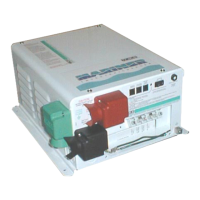,167$//$7,21
&RS\ULJKW7UDFH(QJLQHHULQJ&R,QF 7HOHSKRQH 3DUW1XPEHU
WK
6WUHHW1( )D[ 2FWREHU
$UOLQJWRQ:$86$ ZZZWUDFHHQJLQHHULQJFRP 3DJH
'&&DEOLQJ
This sections describes DC cabling requirements and recommendations including cable sizing, DC
conductor ampacity ratings, overcurrent devices, terminals and lugs, and DC negative terminal
connections.
Battery Cable Sizing
The bigger the battery cables the better. Undersized cables result in additional stress on the inverter,
lower efficiency, reduced surge power and lower peak output voltage. Don’t use cables that are too
small in diameter. The following table gives recommended cable sizes for the various cable-run
lengths and inverter voltages.
Table 4, Recommended Battery Cable Size (In free air)
Inverter
Model #
Typical DC
Amps
1 to 3 feet
One Way
3 to 5 ft
One Way
5 to 10 ft
One Way
M2012 200 Amps 00 0000 0000
M2512 250 Amps 0000 0000 0000
M3012 300 Amps 0000 0000 0000
The term “free air” is defined by the NEC as the cabling not being enclosed in conduit or raceway.
Enclosed cables have a substantially lower continuous current carrying ability due to heating factors.
Battery Cable Inductance
When current passes through a conductor, a magnetic field is set up around the conductor. As this
magnetic field builds, it induces voltage in any conductor that is close by, which induces a voltage in
the original conductor. The voltage induced into the original conductor is called self-inductance, and
tends to oppose the current that produced it. Induced voltage changes cause ripple in the battery
cables that must be absorbed or filtered by the filter capacitors in the inverter. This ripple will lead to
eventual premature breakdown of the filter capacitors and performance loss in the inverter.
When a distance separates positive and negative battery cables, they have much more inductance
than if they are close together. When cables are separated, the magnetic fields add together and
increase the inductance of the battery cables. With only a foot of distance between the battery
cables, the inductance almost doubles. At four feet between cables the inductance is nearly three
times the inductance of cables adjacent to one another.
In addition to the problems mentioned, the induced current opposes the applied current (battery
current) which directly causes a loss of inverter performance as greatly reduced efficiency.

